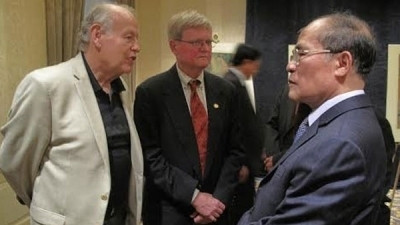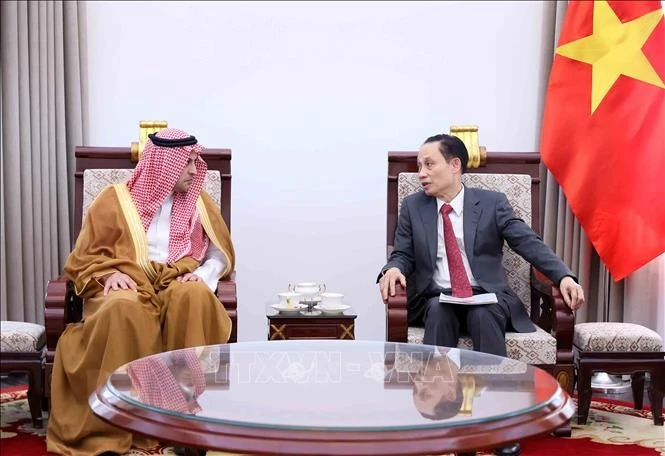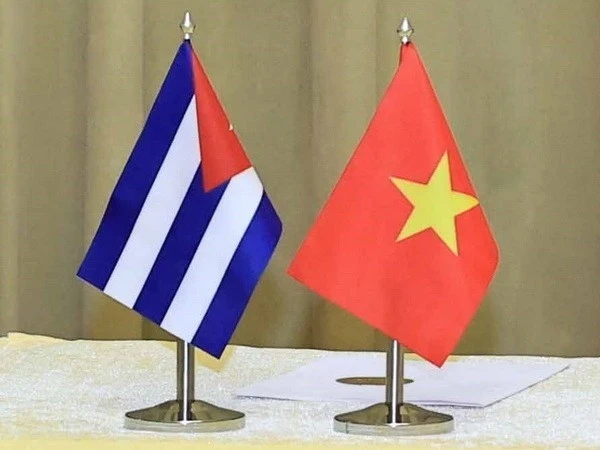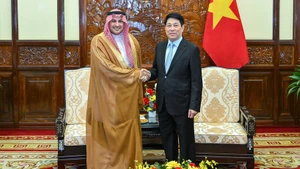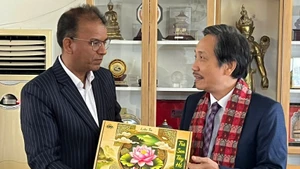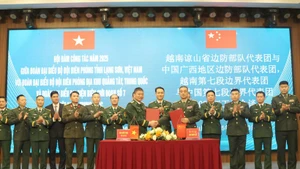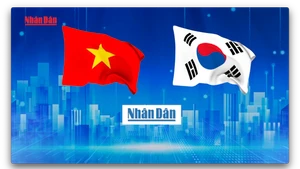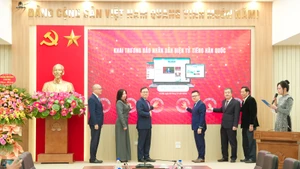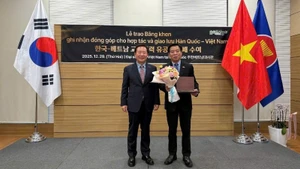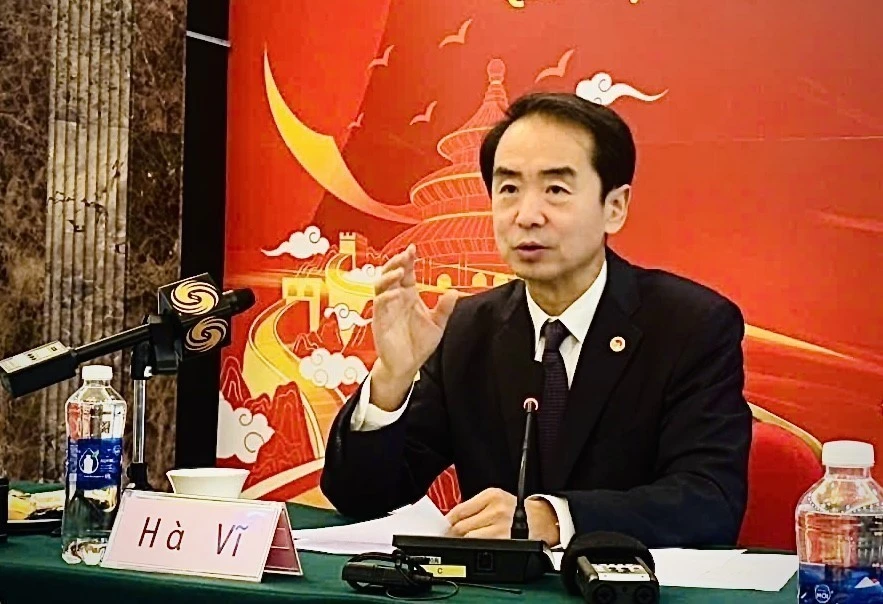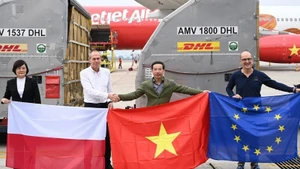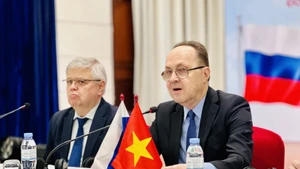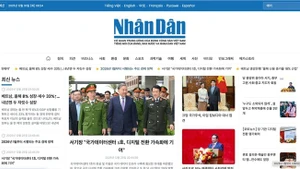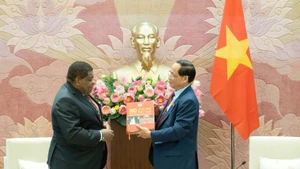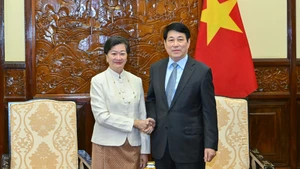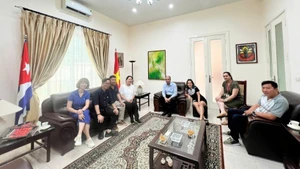Admiring Ho Chi Minh
The deep sentiment of the land and people of Vietnam, felt by Thomas, who joined battles in the Highlands during the American war in Vietnam, has led him to return to the country frequently, visiting numerous localities over the last 50 years to catch up with Vietnamese friends.
During a visit at Ommi Parker Hotel in Boston, Thomas and other US friends, despite working different jobs and living in different states, gathered and expressed their honour to welcome the Vietnamese NA delegation headed by Chairman Hung visiting the US for the first time.
The over-70-year-old artist was moved when visiting the ancient hotel’s basement where young man Van Ba – Nguyen Tat Thanh (Ho Chi Minh’s name at that time) used to work on ways to salvage the nation over a century ago.
On the afternoon of the same day, Thomas and history professor Kevin Bowen were respectfully introduced and invited by Vietnamese Ambassador to the US Pham Quang Vinh to make presentations to the delegation on their meticulous research.
The image of President Ho Chi Minh, Vietnam’s most respected leader, once the patriotic young man going by the name of Nguyen Tat Thanh, is always respected and appreciated by international friends. Thomas introduced his representative works depicting Uncle Ho to Chairman Hung and representatives from the overseas Vietnamese and student communities in Boston. He presented Chairman Hung with two books – ‘President Ho Chi Minh’s Portrait’ and ‘Agent Orange’.
David Thomas at a base in the Highlands region, Vietnam
Thomas said that between 1969 and 1970 he was in Pleiku and Kon Tum working as an infantry soldier building routes for campaigns. He recounted that when he heard the news of Ho Chi Minh’s death, it was the first time he learned of Uncle Ho. In 1987 Thomas returned to Vietnam and conducted researches and programmes on cultural and educational exchanges between Vietnam and the US.
As the founder and director of the Indochina Arts Partnership, a non-governmental and non-for-profit organisation supporting cultural exchange activities between Vietnam and the US, Thomas has made over 50 trips returning to Vietnam.
Accessing matters with view from Vietnam
Thomas said that he was surprised when witnessing the daily life of Vietnamese people in different regions. He noticed that Uncle Ho’s picture would usually be hung high on the wall in people’s homes beside photos of family ancestors upon the altar, showing the Vietnamese people’s great respect to President Ho Chi Minh.
| “How US people studying the American war can overlook such an important figure as Ho Chi Minh. When they look at the war from the perspective of the Vietnamese people, they will see the picture much more clearly", Thomas told the press recently. |
Like many other Americans, despite a large geographical distance with Vietnam, Thomas was deeply impressed by Uncle Ho’s picture displayed everywhere, as well as the countless materials, articles and books published on Uncle Ho. Thomas has painted over 50 portraits of the leader. Between 1992 and 2000, he completed 50 paintings after undertaking thorough and objective studies on the leader via researching books written by Vietnamese, Soviet Union, French and US authors. Before that, he had not known much about President Ho Chi Minh – he had not known that the leader of Vietnam once lived in Boston or that he could compose poems in several languages, including English, Ho Chi Minh even quoted several sentences in the US Independence Declaration in Vietnam’s Independence Declaration.
As an artist, Thomas often painted portraits of Ho Chi Minh inspired by the books he read about the Vietnamese leader. After completing 50 portraits in 2000, he organised numerous exhibitions in California, Maine, New Hampshire and Massachusetts as he wanted his works to spark off discussions and exchanges about the real Ho Chi Minh in the US, different to the mainupulated views of the American public during the 1960s and 1970s.
It was reported that the exhibitions generated a lot of discussion in the community and wider society, several organisations even raised objections to them. Recognising that the outcomes were not as expected, Thomas decided to write a book about Ho Chi Minh, based on another work by Charles Fenn, in order to gain wider access to the public.
| The recently published book written by David Thomas is 110 pages in total and includes his 50 portraits of President Ho Chi Minh. The book made of ‘do’ paper (a distinctive material of Vietnamese painting for printing traditional Dong Ho paintings in Thuan Thanh, Bac Ninh province) is contained in a lacquer box, becoming one of a few books collected and listed in the rare book library of such universities as Yale, Cornell, New York, Wellesley College and Boston Public Library. |
He said that he wrote the book to help the US people understand more about Ho Chi Minh and the war in Vietnam. Now, there are thousands of books about Vietnam and the war between the two countries, but when he began the writing, there was only the one book by Charles Fenn.
Thomas said that although over 100 books written by him were collected by museums and libraries, access to them by the public was still not as expected. Making another attempt, he worked with Lady Borton to publish another book in 2001. The book sold out immediately in Vietnam. Thomas hoped that he could reprint and publish the book in the US to help the US people further their understanding of Ho Chi Minh, the great leader of Vietnam, and about the South-East Asian nation imbued with a unique culture and diverse identities.
‘Agent Orange’ and postwar wounds
The war receded but Thomas still took on writing and publishing the book ‘Agent Orange’ in English. He presented the precious book to Chairman Hung at Ommi Parker Hotel in Boston. The book’s cover was designed impressively with a drum containing toxic chemicals which the US Army used in battlefields in Vietnam.
Thomas spent a month taking photos of an orange flower from it first blooming to it withering and dying to convey a message the brutal destruction of poisons used in the war.
He said that many American people know of the anguish of US veterans exposed to Agent Orange but few people know or care about the chemical’s consequenses on Vietnamese people. He was safe from being contaminated but he felt deeply sorry for many unlucky Vietnamese people and children.
As a result, Thomas has operated the Indochina Arts Partnership for years to help US people understand more about the culture and people of Vietnam and raise awareness about the fact that many Vietnamese people are still suffering from the war’s consequences though it has been over for 40 years, including the severe consequences from Agent Ogange and problems related to unexploded ordinance including mines and bombs left over from the war.
| As Director of the Indochina Arts Partnership, David Thomas has invited over 100 artists, cultural and arts officers from Vietnam and over 100 US artists to join exchange programmes on Vietnamese culture, arts and education. He has helped to organise many Vietnamese art exhibitions and published several books about Vietnamese arts. |
